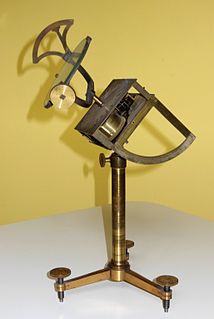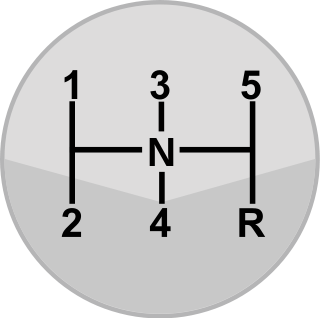
A sextant is a doubly reflecting navigation instrument that measures the angular distance between two visible objects. The primary use of a sextant is to measure the angle between an astronomical object and the horizon for the purposes of celestial navigation.

In telecommunications, a repeater is an electronic device that receives a signal and retransmits it. Repeaters are used to extend transmissions so that the signal can cover longer distances or be received on the other side of an obstruction. Some types of repeaters broadcast an identical signal, but alter its method of transmission, for example, on another frequency or baud rate.

A potentiometer is a three-terminal resistor with a sliding or rotating contact that forms an adjustable voltage divider. If only two terminals are used, one end and the wiper, it acts as a variable resistor or rheostat.

An antenna tuner is a device that is inserted between a radio transmitter and its antenna; when properly adjusted (tuned) it improves power transfer by matching the impedance of the radio to the impedance of the antenna, or the feedline which connects the antenna to the transmitter.

A transmission is a machine in a power transmission system, which provides controlled application of power. Often the term 5-speed transmission refers simply to the gearbox, that uses gears and gear trains to provide speed and torque block conversions from a rotating power source to another device.

A sound reinforcement system is the combination of microphones, signal processors, amplifiers, and loudspeakers in enclosures all controlled by a mixing console that makes live or pre-recorded sounds louder and may also distribute those sounds to a larger or more distant audience. In many situations, a sound reinforcement system is also used to enhance or alter the sound of the sources on the stage, typically by using electronic effects, such as reverb, as opposed to simply amplifying the sources unaltered.

A steering wheel is a type of steering control in vehicles.

A two-way radio is a radio that can both transmit and receive radio waves, unlike a broadcast receiver which only receives content. It is an audio (sound) transceiver, a transmitter and receiver in one unit, used for bidirectional person-to-person voice communication with other users with similar radios. Two-way radios are available in stationary, mobile, and hand-held portable models. Hand-held two-way radios are often called walkie-talkies, handie-talkies or hand-helds. Two-way radios are used by groups of geographically separated people who need to keep in continuous voice communication, such as aircraft pilots and air traffic controllers, ship captains and harbormasters, emergency services personnel like firefighters, police officers, and ambulance paramedics, taxi and delivery services, soldiers and military units, fast food and warehouse employees, and radio amateurs.

A heliostat is a device that includes a mirror, usually a plane mirror, which turns so as to keep reflecting sunlight toward a predetermined target, compensating for the sun's apparent motions in the sky. The target may be a physical object, distant from the heliostat, or a direction in space. To do this, the reflective surface of the mirror is kept perpendicular to the bisector of the angle between the directions of the sun and the target as seen from the mirror. In almost every case, the target is stationary relative to the heliostat, so the light is reflected in a fixed direction. According to contemporary sources the heliostata, as it was called at first, was invented by Willem 's Gravesande (1688–1742). Other contenders are Giovanni Alfonso Borelli (1608–1679) and Daniel Gabriel Fahrenheit (1686–1736).

A rear-view mirror is a flat mirror in automobiles and other vehicles, designed to allow the driver to see rearward through the vehicle's rear window.

The Mercedes-Benz W221 is a chassis code of S-Class, the successor of the Mercedes-Benz S-Class (W220) and the predecessor of the Mercedes-Benz S-Class (W222). The S-Class are the flagship vehicles of Mercedes-Benz and each generation typically introduces a range of technical innovations and developments that over time will find their way into smaller cars.

The lighting system of a motor vehicle consists of lighting and signalling devices mounted or integrated at the front, rear, sides, and in some cases the top of a motor vehicle. They illuminate the roadway ahead for the driver and increase the vehicle's visibility, allowing other drivers and pedestrians to see its presence, position, size, and direction of travel, and its driver's intentions. Emergency vehicles usually have distinctive lighting equipment to warn drivers and indicate priority of movement in traffic.

A gear stick, gear lever, gearshift or shifter, more formally known as a transmission lever, is a metal lever attached to the transmission of an automobile. The term gear stick mostly refers to the shift lever of a manual transmission, while in an automatic transmission, a similar lever is known as a gear selector. A gear stick will normally be used to change gear whilst depressing the clutch pedal with the left foot to disengage the engine from the drivetrain and wheels. Automatic transmission vehicles, including hydraulic automatic transmissions, automated manual and older semi-automatic transmissions, like VW Autostick, and those with continuously variable transmissions, do not require a physical clutch pedal.

A side-view mirror, also known as a wing mirror, is a mirror placed on the exterior of motor vehicles for the purposes of helping the driver see areas behind and to the sides of the vehicle, outside the driver's peripheral vision.

A sun visor is a component of an automobile located on the interior just above the windshield. They are designed with a hinged flap that is adjustable to help shade the eyes of drivers and passengers from the glare of sunlight.

An oscilloscope, previously called an oscillograph, and informally known as a scope or o-scope, CRO, or DSO, is a type of electronic test instrument that graphically displays varying signal voltages, usually as a calibrated two-dimensional plot of one or more signals as a function of time. The displayed waveform can then be analyzed for properties such as amplitude, frequency, rise time, time interval, distortion, and others. Originally, calculation of these values required manually measuring the waveform against the scales built into the screen of the instrument. Modern digital instruments may calculate and display these properties directly.

An optical landing system (OLS) is used to give glidepath information to pilots in the terminal phase of landing on an aircraft carrier.

Guitar wiring refers to the electrical components, and interconnections thereof, inside an electric guitar. It most commonly consists of pickups, potentiometers to adjust volume and tone, a switch to select between different pickups, and the output socket. There may be additional controls for specific functions; the most common of these are described below.

Car controls are the components in automobiles and other powered road vehicles, such as trucks and buses, used for driving and parking.

The Aston Martin Vulcan is a two-door, two-seat, high-performance lightweight track-only car launched in 2015 by British luxury automobile manufacturer Aston Martin at the 2015 Geneva Motor Show.




















